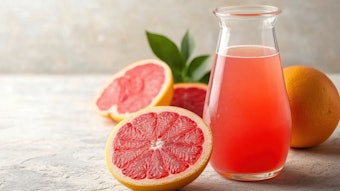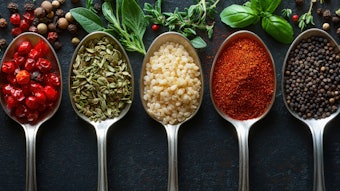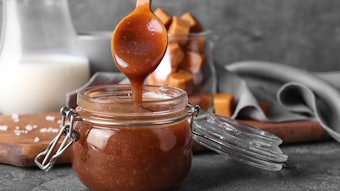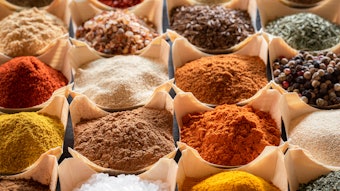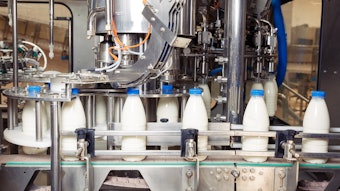
Ethyl octanoate (FEMA # 2449, CAS # 106-32), also commonly called ethyl caprylate, forms the fruity core of the aroma of all yeast fermentations. This makes it an essential ingredient in all fermented flavors, ranging from beer to whisky. Less obviously, it also serves as a useful sensory link between the bright esters and the heavier taste background ingredients in many fruit flavors. Much more unexpected is the fact that ethyl octanoate can also subtly enhance many savory and brown flavors.
Note that the dose rates given throughout this article are the levels suggested for use in flavors intended to be dosed at 0.05% in ready-to-drink beverages or in a simple bouillon.
Alcoholic Drink Flavors
Beer: Beer flavors are an obvious use of ethyl octanoate, providing a bright, yeasty note. Levels vary dramatically with the style of beer, ranging from around 100 ppm up to 1,000.
Brandy: The fruity, yeasty note in brandy and Cognac flavors is very pronounced. Three thousand ppm is a typical starting level of addition.
Rum: Ethyl octanoate plays a less dramatic role in rum flavors, at levels ranging from 200 to 600 ppm.
Tequila: Similar levels work equally well in tequila flavors, attractively grounding the lighter notes.
Whisky: This is also true for all styles of whisky flavors. Ethyl octanoate mitigates the harsh fusel notes of the dominant aliphatic alcohols.
Wine: Ethyl octanoate, used at a moderate level, contributes to all wine flavors. Two hundred ppm works well, shading higher in some red wine flavors.
Tropical Fruit Flavors
Durian: Durian flavors are surprising, underneath the powerful sulfur notes lies an attractive creamy, fruity background. Ethyl octanoate contributes at levels of addition around 100 ppm.
Guava: Guava flavors are much more readily approachable than durian flavors, but the ideal level of this ingredient is the same, 100 ppm.
Kiwi: Fifty ppm of this material helps to round out kiwi flavors and add a modest level of complexity.
Lychee: The effect in lychee flavors is even more subtle, and 20 ppm of ethyl octanoate is all that is required.
Mango: Ethyl octanoate helps round out all styles of mango flavors and balance the mango skin notes. One hundred ppm works well.
Mangosteen: One hundred ppm is also an effective level in mangosteen flavors.
Passionfruit: There is an obvious continuity between ethyl octanoate and the lower ethyl esters in passionfruit flavors. Five hundred ppm is a reasonable starting level but can often be adjusted upwards.
Pineapple: Exactly the same connection works well in pineapple flavors and similar levels, 500 ppm and up, work equally well.
Orchard Fruit Flavors
Apple: Apple flavors generally rely on ethyl 2-methyl butyrate as their key ester. Ethyl octanoate can add welcome depth at around 200 ppm.
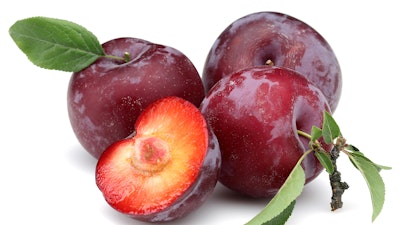 While levels vary, 200 ppm is usually effective for plum flavors.mates at Adobe Stock
While levels vary, 200 ppm is usually effective for plum flavors.mates at Adobe Stock
Pear: This ester provides a pleasant contrast in pear flavors to the predominant iso-amyl and hexyl esters. The level needs only be modest, around 30 ppm.
Plum: Ethyl octanoate fits well to the overall profile of plum flavors. Levels vary, but 200 ppm is effective.
Prune: The effect of ethyl octanoate in prune flavors is similar but the levels are generally higher, in the region of 500 ppm.
Other Fruit Flavors
Blackberry: The most effective levels for ethyl octanoate in the remaining categories of fruit flavors are generally quite a lot lower. Fifty ppm works well in blackberry flavors.
Blackcurrant: Fifty ppm is also ideal in blackcurrant flavors, rounding out the center of the profile.
Grape, Concord: The same 50 ppm-level also performs well in Concord grape flavors.
Orange: Ethyl octanoate can add interest to citrus flavors, especially orange, tangerine and grapefruit. The level of addition should be very low, in the range from 5 to 10 ppm.
Raspberry: Ethyl octanoate performs the same function in raspberry flavors, forming part of the heart of the profile. Once again, 50 ppm works well.
Strawberry Ethyl butyrate is usually central to strawberry flavors. If a high level of ethyl butyrate is used, then around 100 ppm of ethyl octanoate will not be out of place.
Savory Flavors
Beef, Roast: Savory flavors, as a general category, are not a very obvious home for ethyl octanoate. Nevertheless, it does help round out and deepen the more traditional savory raw materials. Sixty ppm works well in roast beef flavors.
Bread: Bread flavors are an obvious exception within the savory category. Levels ranging from 20 to 200 ppm are interesting, depending on the level of fermented note required. 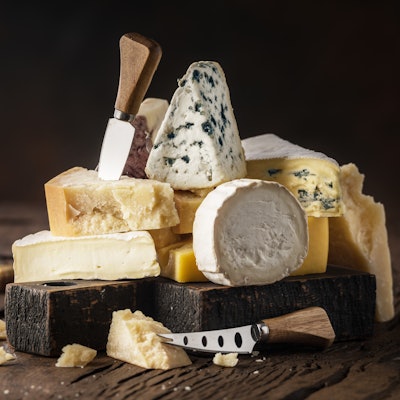 Ethyl octanoate has a role in all cheese flavors.volff at Adobe Stock
Ethyl octanoate has a role in all cheese flavors.volff at Adobe Stock
Cheese: Ethyl octanoate has a role in all cheese flavors, ranging from 10 ppm in Cheddar, to 700 in Parmesan, up to 2,000 in Roquefort and other blue cheese flavors.
Ham: Ethyl octanoate is effective in all ham and pork-related flavors at levels of addition around 200 ppm.
Lamb: The effect of this ingredient in lamb flavors is similar to that in roast beef flavors, although the level can be higher, around 100 ppm.
Olive: The fruity note in olive oil flavors is often built around obvious esters, such as ethyl 2-methyl butyrate. Ethyl octanoate provides additional depth at around 500 ppm.
Seafood: Modest levels, around 50 ppm, work best in seafood flavors of all types. The most successful type is salmon flavors.
Other Flavors
Butter: Ethyl octanoate can add a subtle twist to all dairy flavors. Addition of 20 or 30 ppm work well, especially in butter and cream flavors.
Chocolate and Cocoa: This ingredient can enhance cocoa flavors and the dairy aspect of chocolate flavors. Levels range from 10 to 30 ppm.
Coconut: All coconut flavors can make use of ethyl octanoate, typically around 20 ppm, perhaps a little less for coconut milk flavors.
Cucumber: Cucumber flavors tend to be formed around a predictable unsaturated aldehydic core. Ethyl octanoate adds depth and complexity at levels around 50 ppm.
Elderflower: Ethyl octanoate is a million miles away from being a floral note, but it forms an important part of elderflower flavors. Levels vary, but 100 ppm is a reasonable place to start.




